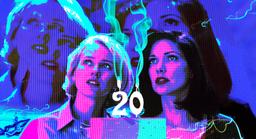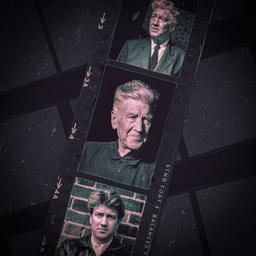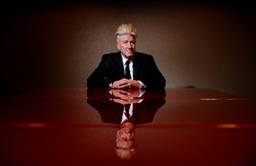I have a good David Lynch story. Well, actually, I have two, and they’re connected. But the first one is better.
In 2006, I managed to get an interview with Lynch for a Toronto alt-weekly, tied to the release of Inland Empire. He called me from his office in New York and parried what I hoped were not incredibly stupid questions about the movie’s Möbius-strip storytelling and nightmare-fuel imagery; knowing that the only thing Lynch liked to talk about less than his intentions were other people’s interpretations of his work, I tried to keep my side of the conversation swift and self-effacing, and to let him take things wherever he wanted. Thirty minutes seemed like five and he said he had to go; I stammered my appreciation and picked up my tape recorder, ready to transcribe the conversation.
Except there was no conversation. Or rather, there was only one side to it: mine. I could hear my own voice—high, nasal, more anxious than usual—asking those hopefully-not-incredibly-stupid questions, but every time Lynch responded, there was only a low, ominous rumble. Not static, exactly: more like the whir of an overhead ceiling fan—or the roar of the ocean as heard through the cochlea of a bloody, discarded human ear.
In a panic, I rewound the tape, fast-forwarded it, and played what was on the other side. I changed the batteries. Nothing worked. It was terrifying, but it was also extremely funny. Listening to my recording, it was as if I had been talking to some kind of sentient void: one gracious enough to pause every few moments so I could take a turn. Instead of a cover story on a director who I considered maybe the greatest living American filmmaker, I had, instead, an authentically Lynchian artifact—a record of an experience that defied description. I thought about simply handing that cassette to my editor and asking, “It’s a strange world, isn’t it?” I thought about Bill Pullman in Lost Highway, phoning home to discover that the pale ghoul standing in front of him was somehow also waiting on the other end of the line, laughing at him, as if he’d been expecting something other than the impossible.
Not knowing what to do, I called Lynch’s office back. I prepared for a return of that low, ominous rumble—or maybe for Lynch to show up at my apartment door, cordless phone in hand, saying “call me.” Instead, I got his assistant. I explained the situation and asked if, perhaps, there was some sort of device that prevented outside parties from recording phone conversations, or if this had happened before. He said that it had not. He also said that he was very sorry, but David had a busy day, and wouldn’t be able to repeat the interview. He then asked me to wait a minute. I was placed on hold—actual silence, not a sonic portal to a different dimension—and waited for what felt like forever for the voice to return. Eventually it did. “David says he’s sorry,” explained the assistant. “He says that you can say that he said whatever you like. However you remember it is fine.”
Objectively, Lynch’s death at the age of 78 is a loss for a global film culture that has revered him—correctly and consistently—as a major figure across his extraordinary 50-year career. Taking the full measure of Lynch’s output and influence will be difficult for any eulogist, not least of all because his greatness is bound up in the tension between the consensus view of him as a stylistic innovator and image-maker and the vigorous lack of agreement about what those images mean—or don’t. The critic Michel Chion once praised the French master Jacques Tati’s slapstick humanism by observing that the world seemed to exist in homage to him; for many of us, reality seems made in Lynch’s image. What does it say that the first time I held my infant daughter, I thought of Eraserhead? What does it say that the friend I texted about it answered “same”?
Eraserhead isn’t exactly the primal scene of Lynch’s cinema. It was his first feature, but it elaborated on themes and visuals cultivated in the short, experimental films he produced at the Pennsylvania Academy of the Fine Arts and the American Film Institute. The first DVD box set I ever ordered on the internet was a compilation of Lynch’s shorts, including Six Men Getting Sick, The Alphabet, and The Grandmother—each in their way disturbing, beautiful, and palpably handmade. It’d take more space than I have here to try to trace a throughline between the thrumming, hypnotic sense of menace radiating from those shorts and the ambient malevolence of Inland Empire, but the highest compliment I can pay to Lynch right now is to say that his work was always evolving without ever really changing.
However you remember it is fine. I remember seeing Blue Velvet in a basement with a bunch of stoned middle schoolers impersonating Dennis Hopper; I remember walking home from The Straight Story in tears; I remember going on Twitter after the eighth episode of Twin Peaks: The Return and scrolling through the astonished reactions of friends and strangers. Every time a tweet about something that wasn’t Twin Peaks came up it seemed to break a hole in the space-time continuum. I remember seeing Mulholland Drive the first time, the fifth time, the 10th time, the time somebody threw a shoe at the screen at TIFF Bell Lightbox and nearly started a riot. With Lynch, it wasn’t just about seeing his movies, but living with them for days, and weeks, and years as they sat on your shoulder, making their way slowly up the back of your neck, through your ear and into your mind’s eye. The scenes don’t go away, even the ones you sometimes wish would. You can’t get rid of a Lynch movie, but it’s never quite yours, either. What does Patricia Arquette whisper near the end of Lost Highway? “You’ll never have me?” That sounds about right.
Eraserhead is a great film, a wry and riotous comedy of paternal paralysis that stages a Norman Rockwell tableaux of family dinner inside a dystopian wasteland. So is The Elephant Man, which transplants Eraserhead’s darkly expressionist visuals and soundscape to Victorian England, and contains perhaps the most devastating ending I know, in which John Hurt’s title character authenticates his humanity by laying himself down to sleep, burrowing under the covers for the first time in his life, guided, like all innocent sleepers, back to the womb, and back to his mother, whose photo sits in a frame by his bedside—a precursor to Laura Palmer, trapped forever in a locket.
I could go through all the rest: Dune (not great, maybe, but fitfully brilliant, with more authentic oddness in any one frame than Denis Villeneuve can conjure over the course of an entire franchise) and Blue Velvet (a surrealist coming-of-age fable) and Twin Peaks (an elegy for a homecoming queen who learns the truth at the edge of 17) and Wild at Heart (my least favorite, for what it’s worth), and so on. Through the I-Hate-L.A. trilogy of Lost Highway, Mulholland Drive, and Inland Empire, which peaks during a tour of Hollywood Boulevard sadder and scarier than anything in The Substance. There’s a larger narrative worth tracing here, which is that, having established himself as the weirdest directorial talent of his era with Eraserhead, Lynch subsequently navigated the rocky shoals of studio gentrification, guided gently on his maiden voyage by Mel Brooks (whose friendship with Lynch is the stuff of legend), crashing out with Dune and crafting Blue Velvet in the wreckage. That he took the carte blanche afforded by Blue Velvet’s Oscar-nominated success to infect network airwaves in partnership with Mark Frost with Twin Peaks, which changed people’s ideas about what a prime-time series could be. That he pushed his obsessions as far as he could with Wild at Heart, and then even further through Fire Walk With Me, which alienated detractors and hardcore fans alike. That he embraced his iconoclasm by promoting Lost Highway via negative reviews as a two-thumbs-down experience. That the G-rated detour of The Straight Story represented one modest, incongruous comeback (a benign road-movie twin to Wild at Heart distributed by Disney) and that Mulholland Drive—a scuttled TV pilot refashioned into an inscrutable, irresistible modern noir—represented a bigger, more spectacular one.
Mulholland Drive is routinely cited as one of the best movies of all time. Superlatives can be deadening, even to movies that deserve them, and the brilliance of the work Lynch produced on either side of it—not just Inland Empire and Twin Peaks: The Return, but a deep and rewarding catalog of short films, television commercials, music videos, multimedia projects, and social media archives like his daily Los Angeles weather reports—is well-documented. There is some genuinely great, penetrating criticism on Lynch’s ideas and themes (like Dennis Lim’s book The Man From Another Place) and yet even the best pieces go only so far in identifying what is so singularly unsettling—and emotional—about his work. He could be arch, cruel, and even sadistic, but more than anything, his work was about feelings—ones that hit like lightning bolts. Think of the Club Silencio detour in Mulholland Drive, with Naomi Watts and Laura Elena Harring being serenaded by Rebekah Del Rio and realizing, in agonizing real time, that she’s singing about the fact that their doomed romance is just a bad cover version of love. Is there a better metaphor for Lynch’s artistry than a mysterious woman singing a familiar old torch song in a foreign language and bringing us to tears anyway? The melody is what matters.
In many other ways, Lynch was a recycler of popular culture. Alexandre O. Philippe’s documentary Lynch/Oz examines the theory that the majority of his films are, to varying degree, coded remakes of The Wizard of Oz. It’s a touchstone that speaks to his biography as a middle-American child of the 20th century and the way that he effortlessly blurred the line between waking life and escapist fantasy. Even at its darkest, Lynch’s cinema lives somewhere over the rainbow; in dreams, he walks with us.
My second David Lynch story takes place before the first one. In 2001, I covered the Toronto International Film Festival for the first time, and somehow ended up getting thrown into a hotel room with Lynch for a 10-minute Q&A. He was there to promote Mulholland Drive, which I had watched a couple of days earlier. I was 21, and didn’t know then that asking Lynch to explain his work was a bad idea. He didn’t answer my question about the meaning of a particular sequence in the film, which turned out to be the last question I had time to ask. But then, when the tape recorder was off, he smiled and said, “A thing is what it is, and that’s what it wants to be.”
It was a good quote, but I didn’t get it on record. (I told you the two stories were connected.) So I went off into a corner of the hotel room and repeated it, falling into an impersonation of Lynch in the process. And when David Lynch—who was still in the room—heard me, he didn’t smile, but he wasn’t angry either. He simply just gave me a thumbs-up.
Both times I talked to David Lynch, I ended up talking to myself. I’m still doing it now. So, thanks for listening.


